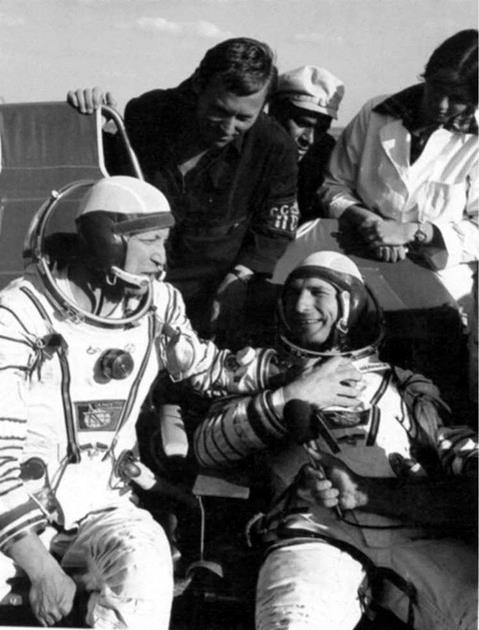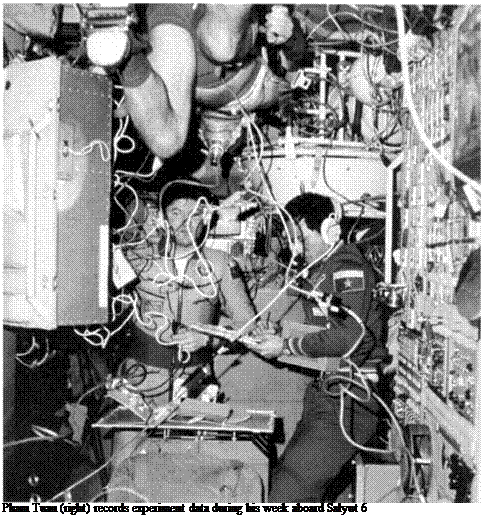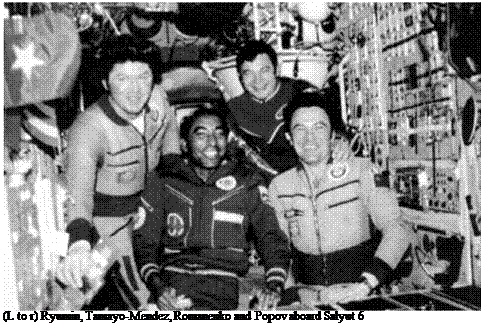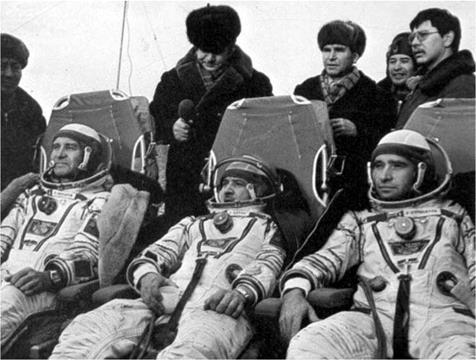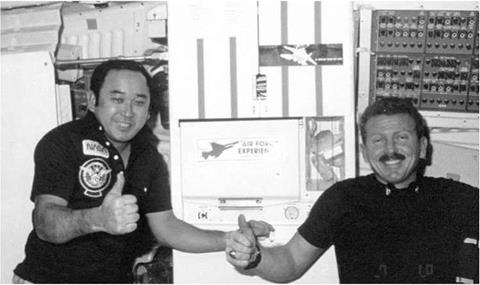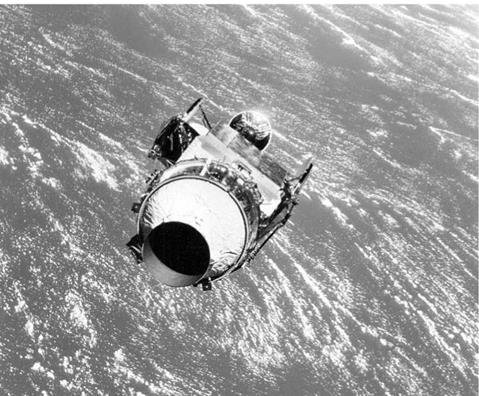. SOYUZ TM33
Flight Crew
AFANASYEV, Viktor Mikhailovich, 52, Russian Air Force, commander, 4th mission
Previous missions: Soyuz TM11 (1990); Soyuz TM18 (1994); Soyuz TM29 (1999)
HAIGNERE, Claudie, 44, civilian, flight engineer, 2nd mission Previous mission: Soyuz TM24 ( 1996)
KOZEEV, Konstantin Mirovich, 33, civilian, flight engineer
Flight Log
The announcement of French cosmonaut Claudie Haignere (formerly Andre – Deshays) to the crew of the second Soyuz Taxi mission had been made in December 2002. With the back-up cosmonaut crew of the first Taxi mission recycled to this flight, this would be a far less controversial mission than that of Dennis Tito, as Haignere had previously completed a visit to the Mir station in 1996. For her new mission, she would be conducting the ESA “Andromede’’ programme of experiments, sponsored by the French Space Agency CNES. Soyuz TM33 docked to ISS on 23 October.
During the week aboard the station, the Derbent cosmonauts assisted their French colleague with her science programme and brought the small cargo of supplies and equipment from the Soyuz to the station. They also exchanged their personal seat liners with those in the TM32 spacecraft, which they would use to return to Earth at the end of their mission. They tested the systems and controls of the returning spacecraft and took air samples from inside the Russian segment of the station for analysis back on Earth, as well as participating in a number of small experiments and research tasks.
Haignere’s science programme included two experiments devoted to the observation of Earth and the study of the ionosphere. There were three experiments in life sciences – in the fields of neuroscience, physiology and developmental biology. There
|
The Soyuz ТМЗЗ crew members examine a storage container in Zvezda during the week aboard the station. From left are Victor Afanasyev, Konstantin Kozeev and Claudie Haignere |
were two physics experiments prepared jointly by ESA and the German Space Agency, and two technology experiments and operational experiments designed to flight-test equipment and develop procedures, initiated by the European Astronaut Corps (EAC).
French high schools also devised educational experiments for the mission, a continuation of similar educational experiments flown during the 1999 French mission to Mir. These educational experiments included a wide range of studies to support science teaching in schools.
Throughout the mission, a French project team located at the Moscow TsUP Control Centre and another at the Toulouse Space Centre provided daily mission support to the flight crew, with two audio links per day and permanent monitoring between ISS and ground control. Haignere received briefing and debriefing sheets via email from the new CADMOS (Centre for the Development of Microgravity Applications and Space Operations) based at Toulouse. Two CNES specialists monitored the docking of Soyuz and activities at TsUP, while at JSC in Houston, French ESA astronaut Michel Tognini provided interface between the support team in France and the one in Moscow, updating them with American activities and monitoring of the mission.
The Derbent crew returned in the Soyuz TM32 spacecraft on З1 October 2001 after a ten-day mission, leaving the newer Soyuz TM33 spacecraft for the ISS-4 crew and further highlighting the benefit of including small programmes of experiments on such Taxi missions in the future.
Milestones
228th manned space flight 92nd Russian manned space flight 85th manned Soyuz mission 32nd manned Soyuz TM mission 3rd ISS Soyuz mission (3S)
2nd Taxi flight 2nd visiting mission
1st European (French) woman to board ISS
. SHENZHOU 6Flight Crew FEI, Junlong, 40, Chinese PLA Air Force, commander NIE, Haisheng, 40, Chinese PLA Air Force, operator Flight Log Five pairs of yuhangyuans trained for the second Chinese manned space flight. One month prior to the flight, three pairs were selected to continue training, one as prime crew and two as back-ups. The prime crew was announced shortly prior to launch, with their back-ups announced as Liu Boming and Jing Haipeng (Team 1), and Zhai Zhigang and Wu Jie (Team 2). Nie and Zhai had backed up Yang two years before. The timing, duration and objectives of the flight were discussed in the western media for months, before an official release indicated an October flight of about five days. Improvements had been made to the launch vehicle, whose assembly was completed on 26 September. The spacecraft was joined to the launch vehicle on 4 October. There had been over 110 upgrades to Shenzhou 6 over its predecessor, in four specific areas: upgrading the spacecraft to support the flight of two crewmembers; upgrading the internal configuration of the crew compartment; improvements to the safety systems; and improvements to the system components. In all, over 40 new items of equipment and six pieces of software were incorporated into the Shenzhou 6. There had also been over 75 upgrades to the launch vehicle since Shenzhou 5. The crew had arrived at the launch site 2 hours 45 minutes prior to launch and were sealed inside their spacecraft about 30 minutes later. The launch was nominal, with powered flight lasting 583 seconds. Twenty-one minutes into the mission, the Shenzhou propulsion system was used to adjust the initial 200 km orbit to one of 211 x 345 km. Shortly after launch, search teams were dispatched to recover the telemetry “black box” ejected from the launcher during the ascent. It was thought
that it included telemetry that had not been downlinked to the ground. It was found 45 minutes after the launch. During the flight, the two crew members conducted regular communication sessions with the ground, reporting on their personal condition and the status of the spacecraft, and speaking with their families. Several changes in orbital parameters were conducted during the five days in space, to test the operational capability of the Shenzhou orbital manoeuvring systems with a crew aboard. During the second orbit, the internal hatch into the OM was opened for the first time, and Fei was the first to enter. Three hours later, Fei swapped places with Nie. Very few details of the orbital activities of the crew were released, but the use of the OM and the extended flight allowed both men to take off their pressure suits for most of the orbital duration. Only one slept at any one time, however, with the second monitoring onboard systems. The crew also shut and pressure-tested the internal hatch integrity, both for when the OM was separated and for the future when the OM would be used as an airlock to perform EVA. They also performed an experiment to test the reactions of the crew within the OM and DM, videotaping their somersaults and movement between the modules. The crew conducted a range of “scientific experiments”, which included Earth observation and monitoring, and research on “biological and material sciences.” Exact details were not forthcoming. The most important “experiment” in relation to future plans for EVA, docking, crew transfer and the creation of a small “space station”, was the habitability studies conducted throughout the five days by both men. As with the previous Shenzhou mission, the OM was separated and left in orbit prior to entry and landing. The “mission” of the OM was officially ended on 15 April 2006 after nearly 3,000 orbits of the Earth, giving mission controllers experience in the extended control of a spacecraft in Earth orbit. Milestones 246th manned space flight 2nd Chinese manned space flight 1st Chinese two-person space flight 1st extended manned test flight of Shenzhou Nie Haisheng celebrates his 41st birthday in space (13 Oct) Emergency escapeAs the early spacecraft were developed from military missiles, they had a very nasty tendency to explode on or shortly after lift-off. Getting these vehicles safe enough to carry a crew – man-rating – was a priority, but to be on the safe side, additional escape methods were developed. All systems are tested many times to ensure their correct operation in the event of an emergency and though no crew would wish to experience launch escape systems in action, it is comforting knowing that there is an option to get out of a bad situation if necessary, assuming you have time to do anything about it, of course. The Soviet Vostok one-man craft employed an ejector seat, which would be used in the event of a launch failure or operationally for pre-landing ejection and parachute descent. In contrast, the Voskhod was the most dangerous of all spacecraft. Adapted from the basic Vostok one-man vehicle, it could carry two cosmonauts with spacesuits, or three without, but it didn’t have any room for ejection seats. The US Mercury and Apollo spacecraft, and the Russian Soyuz spacecraft, utilised a rocket launch escape system during the final stages of the countdown and in the early stages of ascent. The Chinese Shenzhou has a similar rocket escape system to the Russian Soyuz. The Russians have experienced two launch aborts during the forty years of Soyuz operations. During the abort in 1975, the escape tower had been ejected and the crew had to rely on the ballistic abort and return separation sequence, enduring up to 20-G loads for a few seconds. Then in 1983, a Soyuz launch pad abort system was activated when a launch vehicle caught fire on the pad. It exploded seconds after the crew were boosted to safety by the escape tower. The American Gemini spacecraft adopted ejector seats, which could be used prior to launch or during ascent if required. The first four Shuttle orbital test missions also had ejection seats fitted, but these were deactivated after the fourth and final test mission and removed after the fifth flight. The Space Shuttle also has a series of abort modes available during the ascent phase, although, when asked whether they wanted to fly a test mission of these aborts, the astronauts declined, indicating that they would test them when they needed them. In the event of a main engine failure prior to ignition of the twin Solid Rocket Boosters (SRBs), there are options to abort the launch and this has occurred on five occasions in the history of the Shuttle programme. The three official abort modes are Return to Launch Site (RTLS), Trans-Atlantic Abort (TAL) and Abort to Orbit (ATO). RTLS occurs early in the flight if one or more engines are lost. This is the most risky, and many astronauts don’t believe it is survivable, as the stack has to turn around and fly back to the Kennedy Space Center. This would be a severe strain on the structural integrity of the vehicle. A TAL abort is a preferred option, with three prime locations in Europe, while an ATO is the only one to have actually occurred thus far. This was in 1985 during mission STS 51-F, when one engine shut down early during launch. The mission continued normally. It is obvious to all who fly the Shuttle, however, that a failure of an SRB (which occurred on the STS 51-L launch in January 1986) is non-survivable. There are other “contingency” aborts which are not “official” but are nonetheless trained for. The orbiter could shed its External Tank (ET) and conceivably land at Bermuda or other east coast sites in the USA, but this, too, would provide a real challenge for the flight crew – and quite a spectacle for the locals. As the Shuttle launch pads were adapted from the older Apollo Saturn V launch pad, some of the facilities are still available to the crew on the pad in the event of an emergency situation. Should an emergency occur before launch, such as fire after a launch pad abort, the crew would evacuate the Shuttle and use “baskets” on slide wires to descend to the ground, then go through tunnels into an underground bunker. There is also the option of using an armoured personnel carrier to vacate the pad as quickly as possible. Any countdown demonstration test during training on the pad ends with this emergency drill, although it does not include the actual slide wire ride. During the Apollo era, and due to the height of the tower, the crew could have used a slide tube system leading to an underground protected bunker, if they had time to get there! For resident crews on the International Space Station (ISS), and previously on the Soviet Salyut and Mir stations, an emergency return vehicle has always been available – the Soyuz. There is always one attached to the station and when crews become larger as more of the station is built, there will be two attached. NASA has been planning and designing its own Crew Rescue Vehicle but it is unlikely that this will ever be built. The Soyuz is perfectly adequate for the job. It is probable, however, that if NASA build a Crew Exploration Vehicle for the Vision for Space Exploration programme, one or two of these will be docked to the ISS. White Knight and Spaceship OneThe launch aircraft for the Spaceship One vehicle was a manned twin-turbojet research aircraft designed for high-altitude flights. It carried Spaceship One to an altitude of about 50,000 ft (15.24 km) although its ceiling was 53,000 ft (16.15 km) with a payload capacity of 8,000 lbs (3,628 kg). With a crew capacity of three, it could increase its 82ft (25 m) wing to 93 ft (28.3 m) for increased climb capability. Spaceship One featured a three-seat (although for the X-Prize flights, two were ballasted) 60 inch (152 cm) diameter shirt sleeve environment cabin, with space-qualified ECS and dual-pane windows. The unique bullet-shape-with-wings configuration gave aircraft-like qualities for the boost phase, glide and landing. Its “care-free” configuration allowed a hands-off re-entry and reduced aerodynamic and thermal loads by converting to a pneumatic-actuated “feather” configuration, offering a stable, high-drag shape for entry. The motor powering the system was a “new nontoxic liquid nitrous oxide/rubber-fuelled hybrid propulsion system” specifically developed for Spaceship One. MERCURY ATLAS 7
Pad 14, Cape Canaveral, Florida 24 May 1962 Northeast of Puerto Rico, Atlantic Ocean Atlas 107D; spacecraft serial number SC-18 4hrs 56 min 5 sec Aurora 7 Three-orbit mission Flight Crew CARPENTER, Malcolm Scott, 37, USN, pilot Flight Log Mercury Atlas 7, which was originally to have been the first manned orbital flight, was assigned to astronaut Deke Slayton (who would have used the call sign Delta 7), with Wally Schirra as his back-up. On 16 March 1962, it was announced that Slayton would be dropped from flight status because of a “heart flutter”, but his replacement was not Schirra but Glenn’s back-up, Scott Carpenter. This was mainly because Carpenter had more simulator training experience and MA7 was to be a three-orbit affair, like Glenn’s. The mission – the first to be flown by a replacement astronaut – was also to be the first science flight, with experiments to study visibility from space, the behaviour of liquid in weightlessness, to take hand-held photos of weather patterns and the airglow phenomena, and to deploy a five-colour, 74 cm (29 in) diameter balloon extending on a tether about 30 m (98 ft) from the capsule, which Carpenter named Aurora 7 after his hometown street. In retrospect, the astronaut was given too much to do on the flight and as a result, fell behind the schedule, became a bit flustered and was impatient and careless. He was rather unfairly blamed by some fellow astronauts. The flight began at 07: 45 hours at Cape Canaveral after being delayed three times, each for only 15 minutes, because ground fog would make launch monitoring and photography difficult. Carpenter reached 32.5° orbit, with an apogee of 267 km (166 miles) and a maximum speed of 28,242 kph (17,550 mph) and got to work. His spacesuit overheated, he had to make several manual orientation manoeuvres to correct the automatic control system, and before retro-fire he had not even read his pre-retro-fire checklist. While struggling to do three things at once, he inadvertently hit the roof of Aurora 7, discovering the source of Glenn’s “fireflies” as ice particles on the outside. He switched to manual control in preparation for the orientation manoeuvre and forgot to switch off the automatic system, wasting precious fuel.
The spacecraft was at the wrong yaw and pitch angle at retro-fire, which came three seconds late. Carpenter lost his orientation propellant during the re-entry. He gave a continuous, somewhat excitable commentary into a tape recorder during the re-entry and landed 400 km (249 miles) off target, northeast of Puerto Rico at T + 4 hours 56 minutes 5 seconds. He was spotted in a life raft 38 minutes after splashdown, but another two and a half hours elapsed before a helicopter from the USS Pierce picked him up, giving rise to public worries that he had been lost. Milestones 6th manned space flight 4th US manned space flight 4th Mercury manned flight 1st flight by a replacement crew On 17 July 1962, the first X-15 astro-flight to 95.9km (pilot Robert White, 38, USAF) was achieved using the number 3 aircraft. SOYUZ 32
Pad 31, Site 6, Baikonur Cosmodrome, Kazakhstan 19 August 1979 (aboard Soyuz 34) 211 km southeast of Dzhezkazgan R7 (11A511U); spacecraft serial number (7K-T) #48 175 days 0hrs 37min 37 sec Proton (Proton) Third Salyut 6 resident crew programme Flight Crew LYAKHOV, Vladimir Afanasevich, 37, Soviet Air Force, commander RYUMIN, Valery Viktorovich, 39, civilian, flight engineer, 2nd mission Previous mission: Soyuz 25 (1977) Flight Log The original plan for Salyut 6 was to include three long-duration missions, by Soyuz 25, 26 and 28, with visits by Soyuz 27, 29 and 30. The Soyuz 25 failure resulted in a reschedule and at first an anticipated reduction from three to two long-duration missions. By February 1979, however, Salyut’s condition was assessed to be worth a try at the third long-duration mission, by Soyuz 32, during which two further international missions would also be attempted. Soyuz 32, crewed by veteran Valery Ryumin and rookie commander Vladimir Lyakhov, took off in extremely overcast and murky skies at 16: 54 hrs local time. Their record residency aboard Salyut 6, which they entered the following day, was destined to be a long, lonely one. The crew immediately checked over the station and found it in good condition, apart from the confirmation that there was a potentially serious problem with the station’s fuel system. A membrane in a liquid fuel and gaseous nitrogen gas line had warped. Orders were given to launch Progress 5 to start the restocking process. This arrived on 12 March, carrying, among other things, a TV monitor to permit the first two-way visual communications with the ground and an improved Kristall furnace. Before Progress 5 started refuelling, the tank connected to the line which had warped was ingeniously emptied by spinning the space station. This fuel was then transferred into another tank. Each day, the crew embarked on a strenuous two-and-a-half-hour period of exercise to ward off the ill-effects of weightlessness which would be felt on landing back in 1-G. They took the first Soviet shower in space and by the end of March had completed nearly 40 repairs on the station, as well as their scientific work. All was ready for the arrival of Soyuz 33 with a Bulgarian visitor on 11 April. When this
mission failed to dock and had to make an emergency return to Earth, the following Hungarian mission, too, was cancelled, and the resident crew, which reached a maximum altitude of 406 km (252 miles) in the 51.6° orbit, resigned themselves to unmanned visits by further Progress tankers. The sixth of these arrived on 13 May. An unusual step was then taken to ensure that Lyakhov and Ryumin had a fresh ferry vehicle. Soyuz 32 was replaced by Soyuz 34 (1979-049A), which was launched unmanned on 6 June. This docked at the rear and after Soyuz 32 returned unmanned, the crew took Soyuz 34 from the back to the front, in preparation for the arrival of Progress 7. Launched on 28 June, this new tanker delivered a radio telescope called the KRT-10, designed to monitor pulsars and other celestial phenomena. It was pushed through the aft docking port before Progress departed, and as the tanker undocked was automatically unfurled to a diameter of 10 m (33 ft), a record for a space dish antenna. It may have jammed against some of the station’s appendages and not have unfurled correctly however, because after work with the KRT-10, the mission was thrown into a frenzy when the cosmonauts could not discard it in order to clear the aft docking port for another possible Progress launch to replenish the station later. Thanks to the intensive repair work by the cosmonauts, the station was being considered for several more missions, rather than being de-orbited. Therefore, Ryumin, assisted by Lyakhov, made an unscheduled and highly risky spacewalk on 15 August, reminiscent of the Skylab 2 EVA in 1973, to free the KRT using wire cutters. Their 1 hour 23 minute effort was successful. The crew became the first to land in a spacecraft, Soyuz 34, that had been launched unmanned, at T + 175 days 0 hours 37 minutes 37 seconds, 211km (131 miles) south east of Dzhezkazgan. They had to be carried from the capsule and placed in reclining chairs. Although recovered fit and well after four days, Lyakhov and Ryumin at first had difficulty speaking properly and felt the effects of re-adaptation quite starkly; blankets felt like chainmail and beds like boards, they said. Milestones 70th manned space flight 39th Soviet manned space flight 31st Soyuz manned space flight (Soyuz 32 up only) 33rd Soyuz manned space flight (Soyuz 34 down only) New duration record – 175 days 0 hours 1st manned space flight to land in spacecraft launched unmanned 5th Soviet and 20th flight with EVA operations Lyakhov celebrates 39th birthday in space (28 Jul) Ryumin celebrates 40th birthday in space (16 Aug)
Flight Crew RUKAVISHNIKOV, Nikolay Nikolayevich, 46, civilian, commander, 3rd mission Previous missions: Soyuz 10 (1971); Soyuz 16 (1974) IVANOV, Georgy Ivan, 38, Bulgarian Air Force, cosmonaut researcher Flight Log Conditions at the Baikonur Cosmodrome at 22: 34 hrs local time on 10 April were described as the worst ever for a Soviet launch, as the SL-4 booster was committed to lift-off in winds of 40 kph (25 mph). Another international mission was under way, this time with the moustached Bulgarian Georgy Ivanov alongside the first Soviet civilian commander, Nikolay Rukavishnikov, who also happened to be the first non-pilot to command a spacecraft. Soyuz 33 began its orbital manoeuvres for the rendezvous with Salyut 6, reaching a maximum altitude of 261 km (162 miles) at 51.6°, but Rukavishnikov was not happy with the main propulsion system. Instinctively, he knew that something was not quite right and this was confirmed on the control panel, with readings indicating lower chamber pressures than normal. One of the final manoeuvres for the rendezvous was a 6-second burst of the main engine, which fired erratically for 3 seconds and then shut down. The docking was off. The fault was later traced to the gas generator feeding the turbo-pump in the spacecraft’s main engine. While the failure and routine return to Earth of the powerless Soyuz ferry were reported matter-of-factly by the Soviet news agencies, controllers and cosmonauts were very worried about the Soyuz 33 crew’s safety. The back-up propulsion unit would have to be used for the retro-burn and had never been used before on a manned mission. In addition, it was only capable of one continuous burn, rather than a two – phase retro-burn normally used to induce a stress-reduced, 3-G lifting re-entry. The ballistic re-entry would therefore involve much higher g-forces. The nominal back-up engine burn time was 188 seconds, but there was no guarantee that it would perform as
advertised. There was a facility to allow the crew to start it manually if it cut off after burning for at least 90 seconds, but even so, the re-entry would be extremely inaccurate. Anything shorter would have meant them being stranded in orbit. A longer burn than nominal could place an intolerable G-force on the spacecraft and crew. Ivanov was told to make sure he tucked his moustache inside his helmet! Soyuz 33’s back-up engine fired for 213 seconds which was longer than normal and Rukavishnikov had to manually shut it down. For 530 seconds, the crew was subjected to G-forces between 10-G and a peak of 15-G. Rukavishnikov later commented that as the Soyuz DM descended it was like being inside the flames of a blowtorch. Externally, temperatures reached 3,000°C and the crew experienced a lot of vibration and noise. Pinned to their seats by the G forces, both reported difficulty in breathing but were still able to talk to each other. The capsule was glowing red as it landed beneath darkening skies 318 km (198 miles) southeast of Dzhezkazgan at T + 1 day 23 hours 1 minute 6 seconds. Unlike NASA, there are no copies of the post-flight reports of the Soviet accident investigation boards publicly available. Accounts of what happened are left to personal recollections, sometimes years after the event, making for conflicting accounts of the facts. The official RKK Energiya history and the memoirs of Flight Director Alexei Yeliseyev record that the engine failed to provide enough thrust and the deceleration impulse was less than planned. Soviet space analyst and historian Bart Hendrickx has suggested that perhaps the automatic systems on the Soyuz tried to compensate for the inadequate firing of the engine by commanding a longer burn than planned and the crew, unaware of this, simply shut it down. Landing close to the planned recovery site was pure coincidence according to Yeliseyev. Due to the insufficient deceleration, Soyuz 33 took longer to enter the atmosphere, but as a result of the longer engine burn, a steeper angle compensated for the increase descent time. Milestones 71st manned space flight 40th Soviet manned space flight 32nd Soyuz manned space flight 1st manned space flight commanded by non-pilot 1st civilian engineer-cosmonaut to command a Soviet mission 1st manned space flight by a Bulgarian 4th Interkosmos mission
Flight Crew POPOV, Leonid Ivanovich, 34, Soviet Air Force, commander RYUMIN, Valery Viktorovich, 40, civilian, flight engineer, 3rd mission Previous missions: Soyuz 25 (1977); Soyuz 32 (1979) Flight Log Assigned to this next long-duration mission to Salyut 6 were commander Leonid Popov and flight engineer Valentin Lebedev, who injured his knee shortly before liftoff while exercising on a trampoline. Mission officials decided to adhere to the new rule that at least one flight experienced crewman should fly a mission and chose a certain Valery Ryumin as Lebedev’s replacement. So, eight months after coming home from the Soyuz 32 marathon, the tall, burly Ryumin was off again. Soyuz 35 lifted off into a decidedly murky sky at 19: 38 hrs local time on 9 April. Within 26 hours, Soyuz 35 was safely nestled at Salyut 6 and Ryumin entered the station to read a welcoming letter written by himself before he last left. Before Soyuz 35 had arrived, Salyut 6 had received two visits from unmanned spacecraft; the new Soyuz T1 ferry vehicle on an automatic test and a regular tanker visit from Progress 8, which was used to boost Salyut’s orbit and was there ready for unloading when the cosmonauts arrived. The rookie Popov went about his work in such a frenzy of enthusiasm that the experienced Ryumin told him to slow down – they were going to be there for a while. After unloading Progress 8, the cosmonauts discarded it and almost immediately received Progress 9 in order to take on more equipment, including a new motor for a biogravity centrifuge. Progress 9 was also used for the first time to unload water into Salyut 6. Ryumin keenly tended his Oasis space garden and proudly displayed one of its products, a huge cucumber, which he later revealed was a plastic one. The cosmonauts played host to several visiting crews and also unloaded two more Progress tankers. Soyuz 36 arrived with a Hungarian cosmonaut researcher in May, two Soviet cosmonauts arrived in Soyuz T2 in June, Progress 10 arrived the same month, and Soyuz 37 in July, with a crew including a cosmonaut researcher from
Vietnam. A Cuban followed in Soyuz 38 during September, and finally that month Progress 11 arrived and stayed docked for a record 70 days, well after Popov and Ryumin had returned to Earth. These regular visits meant that the resident crew estimated that they spent 25 per cent of their time in Salyut unloading equipment and cosmonauts. One major exercise during a hiatus in the visits during August was a dedicated period of Earth resources photography of targets in the Soviet Union, using the MKF-6M and KT-140 cameras. The approximately 4,500 images covered a total of 96 million km2 (37,056,000 miles2). During the mission Ryumin put on 3.1 kg (7 lb), which was an unusual statistic for a space traveller. He and Popov had reached 365 km (227 miles) maximum altitude during the 51.6° orbit. They boarded the fresh Soyuz 37 and came home 180 km (112 miles) southeast of Dzhezkazgan at T + 184 days 20 hours 11 minutes 35 seconds, remarkably fresh and fit after a new record duration mission, which was not officially recognised as such by the IAF since it only exceeded the previous mission by nine days, not the required ten per cent. Nonetheless, Ryumin, with three flights under his belt, had clocked up almost a year’s space experience, and declared that he was ready to fly to Mars. Milestones 72nd manned space flight 41st Soviet manned space flight 34th manned Soyuz space flight Ryumin celebrates his 41st birthday in space (16 August) 1st person to celebrate two consecutive birthdays in space (Ryumin) Popov celebrates his 35th birthday in space (31 August) 1980-041A 26 May 1980
140 km southeast of Dzhezkazgan R7 (11A511U); spacecraft serial number (7K-T) #52 7 days 20 hrs 45 min 44 sec Orion (Orion) Hungarian Interkosmos visiting mission programme; Soyuz ferry exchange mission Flight Crew KUBASOV, Valery Nikolayevich, 45, civilian, commander, 3rd mission Previous missions: Soyuz 6 (1969); Soyuz 19 ASTP (1975) FARKAS, Bertalan, 30, Hungarian Air Force, cosmonaut researcher Flight Log Regarded with much hullabaloo in Hungary but not elsewhere, Soyuz 36, delayed from June 1979, lifted off from Baikonur at 00: 21 hrs local time on 27 May, carrying cosmonaut researcher Bertalan Farkas and his Soviet commander Valery Kubasov. Farkas arrived inside Salyut 6 bearing succulent gifts of goulash, pate de foie gras, fried pork and jellied tongue, and soon got down to work with his national experiments called Daignost, Balaton, Interferon, Dose, Opros, Andio, Oxymeter, Biosphere, Refraction, Zarya, Bealuca, Eotvos and Ilkeminator. Farkas, who adapted to weightlessness much faster than his flight experienced colleague Kubasov, helped to process gallium arsenide crystals with chromium, assessed the misalignment of instruments due to long exposure to the space environment, made a photographic geomorphological map of the Carpathian Basin, studied hearing and human motor response in weightlessness and attempted to study the behaviour of the cancer fighting drug Interferon in weightlessness. The Interferon experiment was divided into three separate studies: to assess the effect of weightlessness in Interferon production in the lymphatic system on the human body, study changes in Interferon samples in weightlessness, and assess the effect of Interferon on blood samples taken before launch and after landing. The mission, which reached 355 km (221 miles) in the 51.6° orbit, ended with a night landing at T + 7 days 20 hours 45 minutes 44 seconds in Soyuz 35, 140 km (87 miles) southeast of Dzhezkazgan. The fresher Soyuz 36 was left for the resident crew in case of the need for an emergency return.
Milestones 73rd manned space flight 42nd Soviet manned space flight 35th Soyuz manned space flight 1st manned space flight by a Hungarian 5th Interkosmos mission 1980-045A 5 June 1980
198 km from Dzhezkazgan R7 (11A511U); spacecraft serial number: (7K-ST) #07L 3 days 22hrs 19 min 30 sec Yupiter (Jupiter) Manned test flight of new Soyuz T ferry Flight Crew MALYSHEV, Yuri Vasilyevich, 38, Soviet Air Force, commander AKSENOV, Vladimir Viktorovich, 45, civilian, flight engineer, 2nd mission Previous mission: Soyuz 22 (1976) Flight Log After the unmanned Soyuz T1 test flight in 1979, the cautious Soviets decided to test the new vehicle again on a short mission with a crew aboard. Wearing new style space – suits, Yuri Malyshev and Vladimir Aksenov lifted off from Baikonur at 20: 19hrs local time, heading for a totally automatic rendezvous and docking with Salyut 6. The hands-off docking became a hands-on one from 210 m (689 ft) because the avionics aboard the new ship failed. Malyshev and Aksenov, who reached a maximum altitude of 349 km (217 miles) at 51.6°, spent a brief time with Salyut 6 hosts Ryumin and Popov before heading home, departing the station 2 days 17 hours 22 minutes after docking. En route, they jettisoned the Orbital Module before rather than after retro-fire to save fuel and, according to some western analysts, possibly to demonstrate that an Orbital Module could be left attached to Salyut to act as a special laboratory. Soyuz T2 came home at T + 3 days 22 hours 19 minutes 30 seconds, 198 km (123 miles) from Dzhezkazgan, with black soot covering its windows after the fiery re-entry and with the aid of larger deceleration rockets to aid touchdown. Milestones 74th manned space flight 43rd Soviet manned space flight 36th Soyuz manned space flight 1st Soyuz T manned space flight
Pad 1, Site 5, Baikonur Cosmodrome, Kazakhstan 31 July 1980 (in Soyuz 36) 179 km southeast of Dzhezkazgan R7 (11A511U); spacecraft serial number (7K-T) #53 7 days 20 hrs 42 min Terek (Terek) Vietnamese Interkosmos visiting mission programme; Soyuz ferry exchange mission Flight Crew GORBATKO, Viktor Vasilyevich, 45, Soviet Air Force, commander, 3rd mission Previous missions: Soyuz 7 (1969); Soyuz 24 (1977) TUAN, Pham, 33, Vietnamese Air Force, cosmonaut researcher Flight Log The Interkosmos international manned missions to Salyut 6 were accompanied by much propaganda, most of which rubbed up many western observers the wrong way. This was particularly true for the flight of Soyuz 37 with cosmonaut researcher Pham Tuan, hailed as the only pilot to have shot down an American B-52 during the Vietnam War, a claim refuted by the USA. One of his tasks during the flight, according to the Soviets, was to study the effects on the Vietnamese countryside, plants and forests of the enormous amounts of defoliants and fire bombs dropped during the conflict. Western sports journalists reporting from the Moscow Olympics – much boycotted as a result of the Soviet invasion of Afghanistan – were told to applaud when told of the launch, which was the usual spectacular event, since it again took place at night, 00: 33hrs local time at Baikonur. Twenty-six hours later, Tuan and his commander Viktor Gorbatko had docked with Salyut 6 to give more company to the residents, Ryumin and Popov. Tuan’s adaptation to weightlessness was rather uncomfortable as he suffered a headache and loss of appetite, but he soon picked up to start his busy schedule of highly scientific tasks, such as taking photos of Vietnam with the MKF-6M camera to reveal details of tidal flooding, silting at river mouths and other hydrological features. The flight ended with a landing in Soyuz 36, at T + 7 days 20 hours 42 minutes, some 179 km (111 miles) southeast of Dzhezkazgan. Maximum altitude reached during the 51.6° mission was 351km (218 miles).
75th manned space flight 44th Soviet manned space flight 37th Soyuz manned space flight 36th (original) Soyuz manned space flight 1st manned space flight by a Vietnamese 6th Interkosmos mission 1980-075A 18 September 1980
26 September 1980 17 km southeast of Dzhezkazgan R7 (11A511U); spacecraft serial number (7K-T) #54 7 days 20 hrs 43 min 24 sec Tamyr (Tamyr) Cuban Interkosmos visiting mission programme Flight Crew ROMANENKO, Yuri Viktorovich, 36, Soviet Air Force, commander, 2nd mission Previous mission: Soyuz 26 (1977) TAMAYO-MENDEZ, Arnaldo, 38, Cuban Air Force, cosmonaut researcher Flight Log Even the most enthusiastic space watcher, except the few in Cuba, would have found the latest Interkosmos mission little more than a monotonous repeat of those that had gone before. Cuban Arnaldo Tamayo-Mendez studied the crystallisation of sucrose in weightlessness for the benefit of his country’s sugar industry on his Soyuz 38 mission, with commander Yuri Romanenko. This began at 01: 11 hrs local time at the Baikonur Cosmodrome and, as usual, 26 hours later, Soyuz 38 homed in on Salyut 6 with its occupants Ryumin and Popov. Other experiments being conducted by Mendez included one in which he wore heavy overshoes, to assess ways of preventing muscular deterioration in space. One unique point about the mission, apart from its Cuban connection, was that at its end it touched down within 2.9 km (2 miles) of the predicted landing point in the most accurate landing in the Soviet space programme to date. Flight time was 7 days 20 hours 43 minutes 24 seconds and the mission achieved a maximum altitude of 350 km (217 miles) in the 51.6° orbit. Milestones 76th manned space flight 45th Soviet manned space flight 38th Soyuz manned space flight
1980-094A 27 November 1980
10 December 1980 129 km southeast of Dzhezkazgan R7 (11A511U); spacecraft serial number #08L 12 days 19hrs 7 min 42 sec Mayak (Lighthouse) Salyut 6 maintenance mission; Soyuz T three-crew test flight Flight Crew KIZIM, Leonid Denisovich, 39, Soviet Air Force, commander MAKAROV, Oleg Grigoryevich, 47, civilian, flight engineer, 4th mission Previous missions: Soyuz 12 (1973); Soyuz 18-1 (1975); Soyuz 27 (1978) STREKALOV, Gennady Mikhailovich, 40, civilian, research engineer Flight Log The first three-crew Soviet manned space flight since the Soyuz 11 disaster of 1971, Soyuz T3 was also the first maintenance mission, designed to overhaul the aging Salyut 6 space station to prolong its already long life sufficiently to accommodate a further three missions, two of which were international flights. Lift-off came at 19: 18hrs local time at Baikonur, carrying rookie commander Leonid Kizim and research engineer Gennady Strekalov, along with the first Soviet space four-timer, Oleg Makarov. Unlike Soyuz T2, this flight made a totally automatic docking with Salyut 6 and a hectic two-week repair mission began. In addition to the busy schedule of repairs, the crew did conduct two science experiments; to study the behaviour of crystals in weightlessness, extensively using the onboard furnaces; and the use of a laser-based holographic system to photograph the dissolution of a salt crystal. Kizim and his colleagues overhauled the hydraulic system on board Salyut, installing a new hydraulic unit and pumps. They also replaced a programming device in the control system, fitted a new transducer to a compressor in the in-orbit refuelling system, and replaced electronic components in the communications system. While the crew was still on board, the Progress 11 tanker’s main propulsion system was fired to raise the station’s orbit. The tanker was then discarded, followed by the crew’s entry into Soyuz T3 and an automatic retro-fire and re-entry to a landing at T + 12 days 19 hours 7 minutes 42 seconds, 129 km (80 miles) southeast of Dzhezkazgan. Maximum altitude achieved during the 51.6° mission was 398 km (247 miles). Salyut was ready for another long-duration visit and in preparation
for it, another Progress was dispatched from Baikonur, to await a new crew. With Soyuz T3 featuring a three-person crew, it proved the greater flexibility of the new spacecraft and opened up the possibility of crewing a Salyut with three residents instead of two, offering greater productivity. However, the Soviets had revealed that on future Soyuz T missions, the crew composition would vary and would not always include a cosmonaut researcher (who had no piloting functions) in the third seat. On occasion, the third seat would be occupied by additional supplies or science experiments. Milestones 77th manned space flight 46th Soviet manned space flight 39th Soyuz manned space flight 2nd Soyuz manned space flight 1st Soviet three-person crew since 1971 STS 51-C |
|
Int. Designation |
1985-010A |
|
Launched |
24 January 1985 |
|
Launch Site |
Pad 39A, Kennedy Space Center, Florida |
|
Landed |
27 January 1985 |
|
Landing Site |
Runway 15 North, Kennedy Space Center, Florida |
|
Launch Vehicle |
OV-103 Discovery/ET-14/SRB BI-015/SSME #1 2109; |
|
#2 2018; #3 2012 |
|
|
Duration |
3 days 1 hr 23 min 23 sec |
|
Callsign |
Discovery |
|
Objective |
First classified dedicated DoD shuttle mission |
Flight Crew
MATTINGLY, Thomas Kenneth, 48, USN, commander, 3rd mission Previous missions: Apollo 16 (1972); STS-4 (1982)
SHRIVER, Loren James, 40 USAF, pilot ONIZUKA, Ellison Shoji, 38, USAF, mission specialist 1 BUCHLI, James Frederick, 39, USMC, mission specialist 2 PAYTON, Gary Eugene, 36, USAF, payload specialist
Flight Log
This mission was originally to have been designated STS-10 and to have flown in January 1984. When it finally got to the launch pad as STS 51-C (originally designated STS-20), it was assigned to orbiter Discovery, rather than Challenger, which was suffering a rather disturbing tile problem. The assignment of Discovery to the mission caused a disruption to the 1985 Shuttle schedules. Although a classified military mission, press leaks resulted in most people knowing full well what the STS 51-C crew would be doing: deploying a geostationary electronic monitoring satellite on an IUS upper stage. It was also unique in that it carried the first military specialist passenger, Gary Payton, from a cadre of US Air Force Manned Space Flight Engineers, most of whom it was anticipated at the time would fly on later military Shuttle missions.
The launch of STS 51-C was delayed by one day by the coldest weather in memory at the KSC and was quite spectacular a day later at 14: 50 hrs. The countdown had not been announced until T — 9 minutes under new rules for military launches, although observers could tell it was in progress a lot earlier by seeing wisps of liquid oxygen coming off the ET. Discovery entered a 28.4° inclination orbit with a maximum altitude of 341 km (212 miles). Trouble with the IUS on the STS-6 mission had been the main reason for this mission’s delay, and after the Acquacade ELINT (electronic
|
USAF astronauts Onizuka (left) and Shriver give the thumbs up during the classified STS 51-C mission |
signals intelligence satellite) had been deployed, the IUS misbehaved again, its first stage thrust shortfall being made up by thruster firings.
Discovery also carried a blood flow experiment but little else was officially reported about the mission, which ended after the shortest five-crew flight of just T + 3 days 1 hour 23 minutes 13 seconds on runway 15 at the KSC.
Milestones
103rd manned space flight
46th US manned space flight
15th Shuttle mission
3rd flight of Discovery
1st US classified manned military mission
1st flight of a Military Spaceflight Engineer (MSE – Payton)
STS-34 |
|
Int. Designation |
1989-084A |
|
Launched |
18 October 1989 |
|
Launch Site |
Pad 39B, Kennedy Space Center, Florida |
|
Landed |
23 October 1989 |
|
Landing Site |
Runway 23, Edwards Air Force Base, California |
|
Launch Vehicle |
OV-104 Atlantis/ET-27/SRB BI-032/SSME #1 2027; |
|
#2 2030; #3 2029 |
|
|
Duration |
4 days 23hrs 39 min 21 sec |
|
Callsign |
Atlantis |
|
Objective |
Galileo Jupiter probe deployment mission |
Flight Crew
WILLIAMS, Donald Edward, 47, USN, commander, 2nd mission Previous mission: STS 51-D (1985)
MCCULLEY, Michael James, 46, USN, pilot
LUCID, Shannon Wells, 46, civilian, mission specialist 1, 2nd mission Previous mission: STS 51-G (1985)
CHANG-DIAZ, Franklin Ramon, 39, civilian, mission specialist 2, 2nd mission Previous mission: STS 61-C (1986)
BAKER, Ellen Schulman, 36, civilian, mission specialist 3
Flight Log
During an extraordinary week in May 1986, two Space Shuttles were to have taken off from both launch pads at the KSC, carrying their Ulysses and Galileo deep space probes, both atop liquid-fuelled Centaur G Prime upper stages. The prospect caused such concern among the astronauts, even before the Challenger disaster, that the flights were dubbed the “Death Star” missions after the Star Wars films. The Challenger accident put paid to such ambitious NASA flight rate plans and resulted in the elimination of the Centaur stage from Shuttles. Galileo and Ulysses were to fly the less powerful solid-propellant IUS upper stages and, instead of taking off six days apart, were to be launched in October 1989 and October 1990 respectively.
Galileo was assigned to the orbiter Atlantis and mission STS-34 with a launch window starting on 12 October and extending well into November if necessary. NASA aimed hopefully for 12 October, having successfully avoided returning Atlantis to the VAB to escape Hurricane Hugo by a whisker. The astronaut crew, including Shannon Lucid and Ellen Baker, the first two-female crew to be launched since October 1984, arrived in good spirits at the KSC on 9 October. They were not in such good spirits flying back to Houston the following day after the launch was cancelled due to a fault in SSME No.2’s main events controller, which had to be replaced.
|
Galileo is deployed from Atlantis atop its IUS to start its long journey to Jupiter |
Atlantis was rescheduled for 17 October and a tight 24 minute planetary launch window. While the crew stared into blue skies, the RTLS Shuttle runway was threatened by a thundercloud and the transatlantic abort sites were also suffering inclement weather. Commander Don Williams took his crew back to their quarters and an attempt the following day seemed destined for more of the same, such were the forecasts. A launch hold was ordered because the orbiter computers had to be reprogrammed for a potential TAL landing at a secondary site due to bad weather at the first, while at the KSC, the weather was perfect for the launch at 12:53 hrs local time, boosted by the first SRBs to use components from previous Shuttle missions since the Challenger disaster.
Once Atlantis had reached its unique 34.30° inclination, with a maximum altitude of 286 km (178 miles), Pad 39B was almost obliterated by thunderstorms. At T + 6 hours 21 minutes, Galileo began its journey to Jupiter, leaving the payload bay on its IUS. It would go backwards to Jupiter via Venus and two Earth fly-bys, one as close as 900 km (559 miles) in December 1990, taking six years to reach its destination.
The flawless departure from the Shuttle, like Magellan’s the previous April, did much to boost NASA’s morale, particularly in light of the criticism of flying these payloads on the Shuttle rather than an ELV and the particular storm in a teacup which brewed over the fact that environmentalists had been concerned about Galileo’s radioactive RTG power system. Such was the ridiculous media hype that local residents near the Cape were led to believe that, had Atlantis gone the same way as Challenger, the effect would have been a nuclear explosion. Adding to the drama was the fact that the IUS control room at a US Air Force facility in Sunnyvale, California was hit by an earthquake just before launch and personnel, some of whom had lost their houses and belongings, were controlling the IUS amid dust and more than a little rubble.
The crew then got to work with film-making using the IMAX camera, medical experiments under the watchful eyes of Dr. Baker, and remote-sensing photography from the unique orbit. Atlantis made a picture perfect touchdown on the dry lake bed runway 23 at Edwards Air Force Base at T + 4 days 23 hours 39 minutes 24 seconds. By the time Galileo soared past Venus in February 1990, two Shuttle flights later, STS-34 was but a statistic on the flight manifest.
Galileo had a long and troubled journey to Jupiter and at times it looked as though the spacecraft might not succeed at all thanks to difficulties with unfurling the antenna. Finally, on 7 December 1995, the probe entered Jovian orbit. The probe had flown past Venus on 10 February 1990, Earth and the Moon on 8 December 1990, and the asteroid Gaspra on 29 October 1991, before returning to the vicinity of Earth and the Moon for a second time on 8 December 1992, passing the asteroid Ida on 28 August 1993, and taking historic images of Comet Shoemaker-Levy striking Jupiter during July 1994. The probe was released on 13 July 1995 and entered the upper atmospheric cloud layers of the planet on 7 December 1995, the same day that the main spacecraft entered orbit. The primary mission (orbits 1-11) ran from January 1996 through December 1997. This was followed by the Europa phase between December 1997 and December 1999 (orbits 12-25), and finally an extended mission phase. A decade after leaving Earth, the Galileo mission continued to rewrite the text books on the largest planet in our solar system. Mostly forgotten was the short mission of STS-34, another mission that blended unmanned and manned space exploration into one programme.
Milestones
128th manned space flight 61st US manned space flight 31st Shuttle mission 5th flight of Atlantis
2nd Shuttle planetary deployment mission
STS-42 |
|
Int. Designation |
1992-002A |
|
Launched |
22 January 1992 |
|
Launch Site |
Pad 39A, Kennedy Space Center, Florida |
|
Landed |
30 January 1992 |
|
Landing Site |
Runway 22, Edwards AFB, California |
|
Launch Vehicle |
OV-103 Discovery/ET-52/SRB BI-048/SSME #1 2026; #2 2022; # 3 2027 |
|
Duration |
8 days 1 hr 14 min 44 sec |
|
Call sign |
Discovery |
|
Objective |
Operation of International Microgravity Laboratory 1 (IML-1) payload; fifty-five experiments devoted to space medicine and manufacturing utilising a Spacelab Long Module |
Flight Crew
GRABE, Ronald John, 46, USAF, commander, 3rd mission Previous missions: STS 51-J (1985); STS-30 (1989)
OSWALD, Stephen Scott, 40, civilian, pilot
THAGARD, Norman Earl, 48, civilian, mission specialist 1, payload commander, 4th mission
Previous missions: STS-7 (1985); STS 51-B (1985); STS-30 (1989)
READDY, William Francis, 39, civilian, mission specialist 2 HILMERS, David Carl, 41, USMC, mission specialist 3, 4th mission Previous missions: STS 51-J (1985); STS-26 (1988); STS-36 (1990)
BONDAR, Roberta Lynn, 46, civilian, Canadian payload specialist 1 MERBOLD, Ulf Dietrich, 50, civilian, ESA payload specialist 2, 2nd mission Previous mission: STS-9 (1983)
Flight Log
As Discovery landed at Edwards AFB in California at the end of the IML-1 mission, the crew were told that their mission had provided a preview of both space station operations and the kind of international cooperation that would be part of future space exploration. As a new Russia emerged from the turmoil of the break-up of the Soviet Union, the Freedom Space Station was itself struggling to survive. But there was a glimmer of hope in the potential cooperation of the Russians in the future programme. However, there was still much to be done on Earth before any hardware would fly in space, but the mission of STS-42 and the first flight of the International Microgravity Laboratory had demonstrated that such cooperation was feasible.
|
The international crew of IML-1 pose for the traditional in space “star-burst” portrait inside the Spacelab module. At top centre is MS Hilmers, and clockwise are commander Grabe, MS Readdy, ESA PS Merbold, payload commander Thagard, pilot Oswald and Canadian PS Bondar. The rotating chair used often in biomedical tests is partially obscured in the centre of frame |
Both the launch and landing of Discovery passed without incident, apart from a one-hour delay to the launch to evaluate indications of power surges from one of the fuel cells. With the vehicle cleared for launch, and safely on orbit just over an hour later, Shuttle operations in 1992 opened with one of the most successful Spacelab missions of all. With the crew operating in two shifts for round-the-clock activity (Red – Readdy, Hilmers, Merbold; Blue – Grabe, Oswald, Thagard, Bondar), operations primarily focused on the adaptation of the human nervous system to low gravity and on the effects of microgravity on other life forms. These included shrimp eggs, lentil seedlings, fruit fly eggs and bacteria. There was also a programme of materials processing experiments, including crystal growth from a range of substances such as enzymes, mercury iodide and a virus. The secondary payloads carried included twelve GAS canisters attached to a GAS Bridge Assembly in the payload bay. This contained numerous US and international experiments, ranging from materials processing to investigations into the development of animal life in weightlessness.
The IML experiment programme was a cooperative effort between the space agencies of the United States (NASA), Europe (ESA), Canada (CSA), France
(CNES), Germany (DARA) and Japan (NASDA). The GAS experiments also originated from multiple countries (Australia, China, Federal Republic of Germany, Japan, Sweden and the United States). There were also two student experiments flown, as well as the IMAX large-format camera and a package of on-going small mid-deck experiments. In all, over 200 scientists from sixteen countries participated in the flight and investigation programme.
Though minor problems occurred, they were all overcome with no adjustments to the flight plan, nor loss of science results. On 24 January, the Mir space station passed within 39 nautical miles of Discovery and the crew reported that the sunlight reflecting off the station looked as bright as planet Mercury when seen after sunset from Earth. On board Discovery, Thagard observed the Russian space station that he would live aboard just three years later. Towards the end of the flight, mission managers concluded that the crew had conserved their consumables so well that they would be able to stay an extra day in orbit to continue their science experiment programme.
IML-1 was the first of a series of four or five such flights that were envisaged over a ten-year period (one flight every two years), dedicated to the study of life and materials sciences and providing important data for planning and executing follow-on research on Space Station Freedom. Such was the success of IML-1 that the prospect of international cooperation on Freedom looked assured, even if the programme itself was floundering due to complexity and cost. Ironically, the revised ISS programme would signal the demise of Spacelab missions due to limited resources. The IML series was reduced from a ten-year programme to just two missions.
Milestones
147th manned space flight
75th US manned space flight
45th Shuttle mission
14th flight of Discovery
1st flight of IML configuration
5th flight of Spacelab Long Module
Readdy celebrates his 40th birthday in space (24 Jan)
Hilmers celebrates his 42nd birthday in space (28 Jan)
1st female Canadian in space (Bondar)











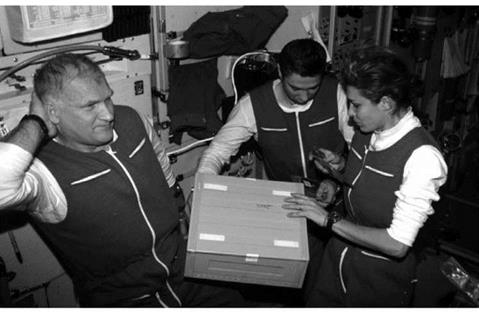
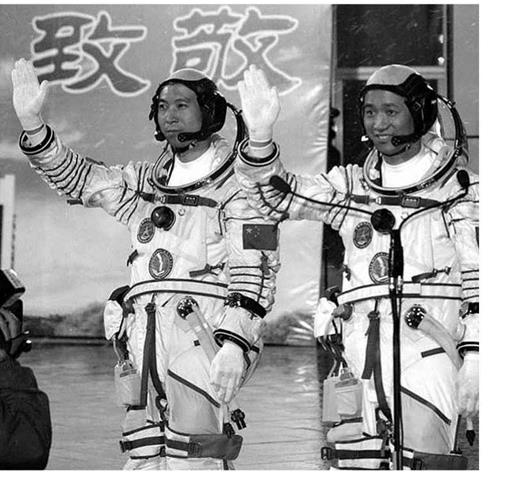
 1962 tau 1 24 May 1962
1962 tau 1 24 May 1962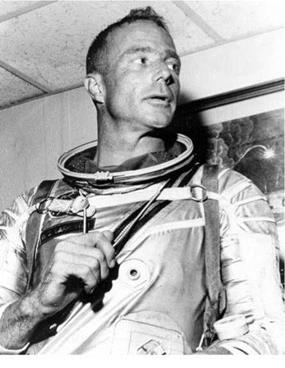
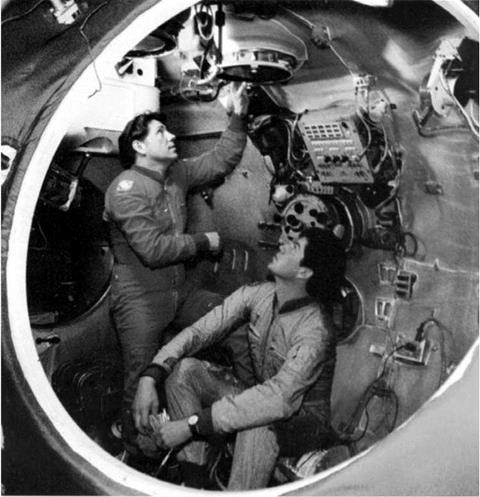

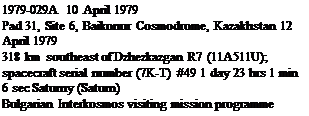
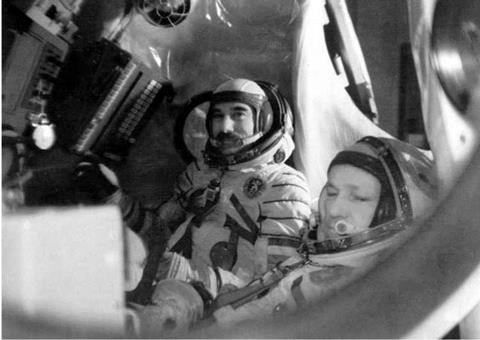

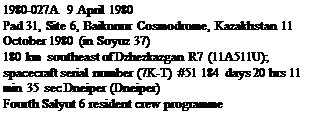
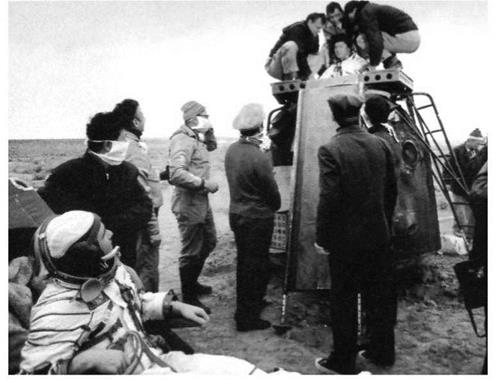
 Pad 31, Site 6, Baikonur Cosmodrome, Kazakhstan 3 June 1980 (in Soyuz 35)
Pad 31, Site 6, Baikonur Cosmodrome, Kazakhstan 3 June 1980 (in Soyuz 35)
